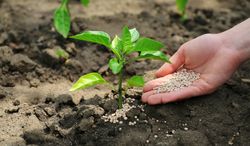
If you visit the garden store for fertilizer, you'll have a wide selection of options—the product you choose matters, as they each have different formulas and are designed for various uses. Plants need a total of 15 major nutrients in their environments, and three of them are the main macronutrients you should look for in synthetic and organic fertilizers.
The Different Types of Fertilizers
1. Nitrogen
Nitrogen is what plants rely on to grow healthy stems and leaves. If you’re buying a packaged fertilizer, look at the label for a series of three numbers, which is the grade. The grade’s first number is often marked with an N, and it tells you the percentage of nitrogen in the product.
2. Phosphate
 Phosphorus, a major component of the chemical phosphate, is essential for developing a strong root system and encouraging flowering plants to bloom. The second number in a fertilizer’s grade is the amount of phosphate in the product.
Phosphorus, a major component of the chemical phosphate, is essential for developing a strong root system and encouraging flowering plants to bloom. The second number in a fertilizer’s grade is the amount of phosphate in the product.
3. Potassium
Potassium is essential for plants to perform photosynthesis, which is the process of turning sunlight into energy. Since this nutrient also helps plants fight diseases, use a potassium-rich fertilizer if you see signs of sickness, like leaf spots and fungus. In fertilizers, a compound called potash is used to provide potassium, and it’s the third number in a grade.
If you’d like to use an organic fertilizer that’s rich in nutrients, visit Garden Exchange in Hilo, HI. Since 1964, this family-owned supply center has provided Big Island gardeners with everything they need to care for their plants, including herbicides, soil, and hand tools. If you’re new to gardening, their friendly team will take the time to walk you through the store and equip you with the basic necessities. View their weekly specials online, or call (808) 961-2875 to ask about their current inventory of organic fertilizers.
About the Business
Have a question? Ask the experts!
Send your question

